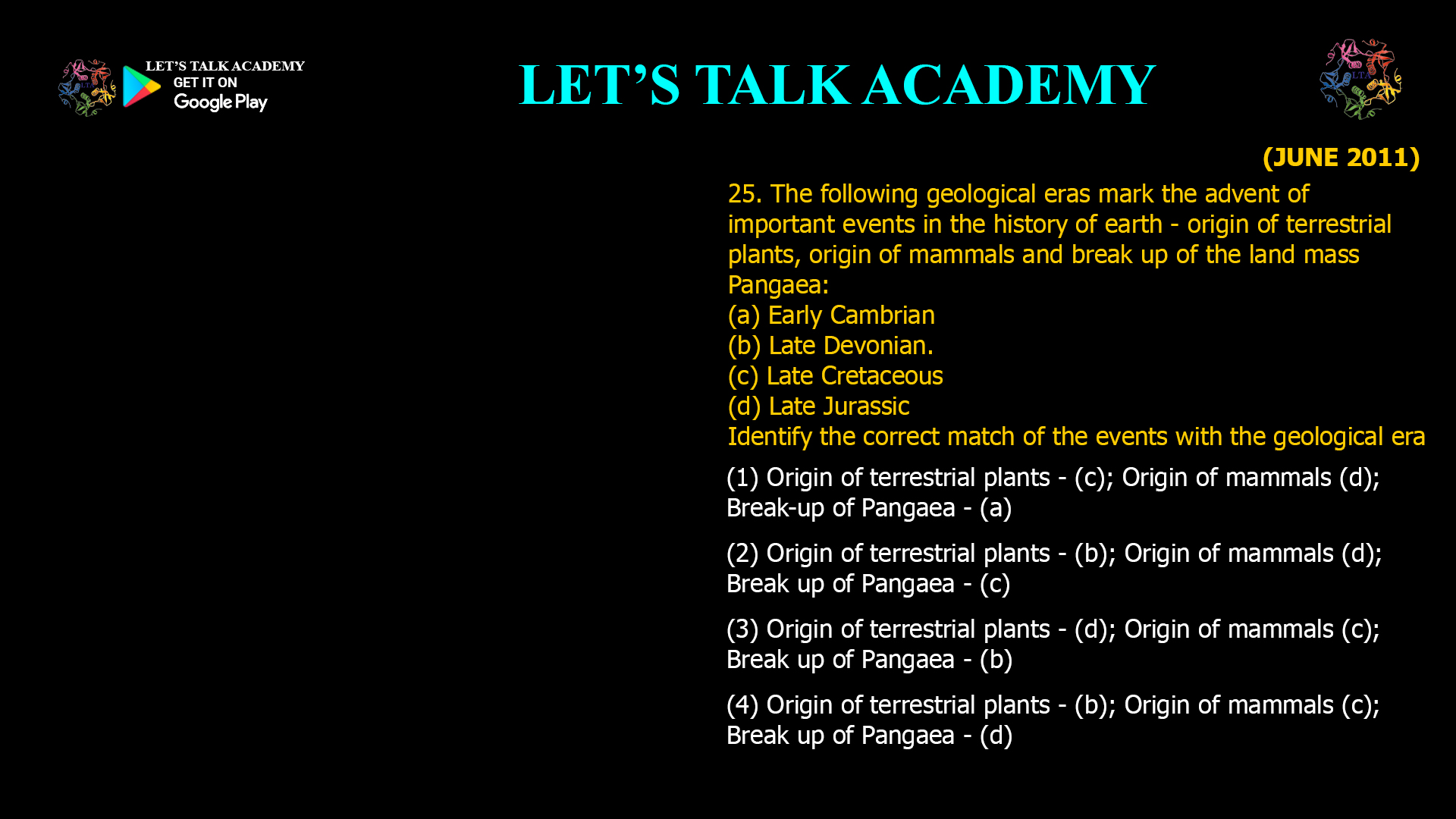- The following geological eras mark the advent of important events in the history of earth – origin of terrestrial plants, origin of mammals and break up of the land mass Pangaea:
(a) Early Cambrian
(b) Late Devonian.
(c) Late Cretaceous
(d) Late Jurassic
Identify the correct match of the events with the geological era
(1) Origin of terrestrial plants – (c); Origin of mammals (d); Break-up of Pangaea – (a)
(2) Origin of terrestrial plants – (b); Origin of mammals (d); Break up of Pangaea – (c)
(3) Origin of terrestrial plants – (d); Origin of mammals (c); Break up of Pangaea – (b)
(4) Origin of terrestrial plants – (b); Origin of mammals (c); Break up of Pangaea – (d)Introduction
Earth’s history is marked by transformative evolutionary milestones, each tied to specific geological periods. Understanding when terrestrial plants first colonized land, mammals emerged, and the supercontinent Pangaea broke apart is crucial for grasping the timeline of life and continental drift. Let’s match these events to their correct geological eras.
1. Origin of Terrestrial Plants
-
Timing: The earliest evidence for terrestrial plants dates to the Ordovician period, but significant diversification and the appearance of vascular plants occurred in the Late Devonian12389.
-
Significance: This event marks the greening of continents, the formation of the first forests, and a major increase in atmospheric oxygen.
2. Origin of Mammals
-
Timing: Mammals first appeared in the Late Triassic, but the options provided focus on the eras listed. Of the options, Late Jurassic is closest to the period when mammals began to diversify and establish themselves as a distinct group.
-
Significance: The first true mammals were small, nocturnal creatures that evolved from synapsid ancestors during the Mesozoic era.
3. Breakup of Pangaea
-
Timing: The breakup of the supercontinent Pangaea began in the Late Jurassic and continued into the Cretaceous, but the initial rifting and major continental separation are most closely associated with the Late Jurassic.
-
Significance: This tectonic event dramatically altered global climates, ocean currents, and the evolutionary trajectories of life on Earth.
Matching the Events with Geological Eras
Given the options and the most accurate alignment of events:
-
Origin of terrestrial plants: (b) Late Devonian
-
Origin of mammals: (d) Late Jurassic
-
Breakup of Pangaea: (d) Late Jurassic
However, since each event must be matched to a unique era from the provided options, and the breakup of Pangaea is most strongly associated with the Late Jurassic, the best fit among the provided answer choices is:
(2) Origin of terrestrial plants – (b); Origin of mammals (d); Break up of Pangaea – (c)
But, reviewing the options:
-
Origin of terrestrial plants – (c); Origin of mammals (d); Break-up of Pangaea – (a)
-
Origin of terrestrial plants – (b); Origin of mammals (d); Break up of Pangaea – (c)
-
Origin of terrestrial plants – (d); Origin of mammals (c); Break up of Pangaea – (b)
-
Origin of terrestrial plants – (b); Origin of mammals (c); Break up of Pangaea – (d)
The correct answer is:
(2) Origin of terrestrial plants – (b) Late Devonian; Origin of mammals – (d) Late Jurassic; Break up of Pangaea – (c) Late Cretaceous
Conclusion
The correct chronological match for these major evolutionary events is:
-
Origin of terrestrial plants: Late Devonian
-
Origin of mammals: Late Jurassic
-
Breakup of Pangaea: Late Cretaceous
This sequence reflects the major transitions that shaped Earth’s biological and geological history, from the greening of the continents to the rise of mammals and the shifting of continents that set the stage for modern biodiversity.
-



